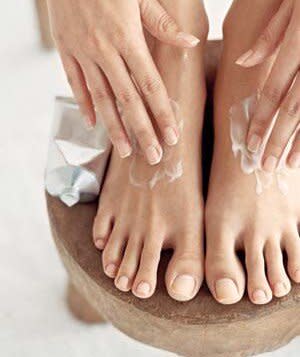Summer Foot Care Tips Checklist

Ericka McConnell
Massage
Coat your palms with a thin layer of lotion or balm. | Look for something infused with a circulation-boosting ingredient, such as peppermint, pine oil, camphor, or rosemary. |
Use long stroking motions. | Slowly massage the sole of one foot with both thumbs, starting behind the toes and moving toward the heel. Apply extra pressure along the arch and at the ball of the foot, two places that are especially prone to tightness. |
Grip the foot with both hands. | Gently twist your hands from side to side as if you're wringing a towel. This may help remove the pain that can develop after hours of standing. End the massage by gently pulling and releasing each toe. |
Repeat on the other foot. |
Strengthening Exercises
Stand barefoot on a wooden or tile floor. | Place a small towel in front of you, with its edge underneath your toes. |
Scrunch up your toes to grip the towel, pulling it toward you, then release. | Repeat until most of the towel is bunched up under your toes. |
Reverse the motion to push the towel away from you. | |
Repeat the entire exercise. | As your feet get stronger, you should be able to complete the sequence three or four times. Rolling your bare foot over a golf or tennis ball can also stretch and strengthen foot muscles while relieving tension. |
Pampering Your Feet
Bring down any swelling with a soak. | Soak feet in a mixture of water, a dozen ice cubes, six drops of tea-tree oil, and rosemary leaves (or use a store-bought tea tree–oil soak). Submerge one foot for 30 seconds, remove from water, then rub vigorously with a towel. Repeat with the other foot, and keep soaking until the swelling subsides. While all soaks help soften skin, certain ones also exfoliate dead skin cells, making feet smoother. Look for products with ingredients such as milk and fruit juices, which contain natural acids that gently dissolve dry, rough patches. |
Soften your feet with a scrub. | Frequent exfoliating is not just about looking good: Thickly callused skin can crack, leading to pain and infections. Pumice-based pastes can swiftly eliminate scaly skin, keeping feet soft for longer. If you prefer scrubs, go for a salt scrub with added oils to help hydrate. Avoid razors and callus scrapers, which can break the skin and cause infection. And be sure to slough gently: Calluses actually protect the feet, so you don't want to strip them away entirely. |
Hydrate the skin with a cream. | Foot creams are generally thicker and more viscous than body formulas because they're supposed to deliver more moisture. The best ones hydrate and soften with petrolatum, glycerin, hyaluronic acid, and shea butter, so make sure one of these is at the top of the ingredient list. If thick, scaly calluses are a persistent problem, use a foot cream that contains exfoliating lactic acid, which dissolves dry patches while it hydrates. Lotions containing urea can also break down calluses and smooth hardened heels. |
